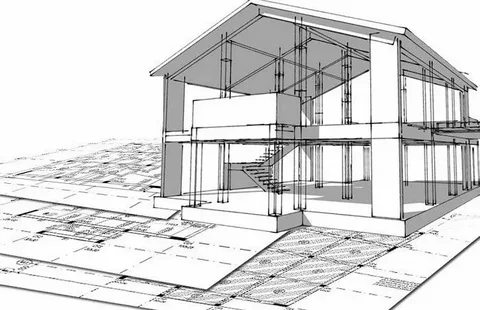Understanding Key Architectural Drawing Types

Understanding Architectural Drawing Types: A Guide for Construction Projects
In the world of architecture and construction, success starts long before the first brick is laid. It begins on paper—or more accurately today, in digital blueprints. Understanding architectural drawing types is crucial not only for architects and engineers, but also for contractors, clients, and anyone involved in delivering high-quality construction services.
These drawings serve as the visual language of the building process. From conceptual sketches to technical blueprints, each drawing type plays a unique role. In this guide, we’ll break down the main types of architectural drawings, their purposes, and how they come together to bring structures to life.
Why Architectural Drawings Matter in Construction
Architectural drawings are the foundation of every building project. They help communicate complex ideas clearly, ensure compliance with building codes, guide cost estimation, and act as a reference throughout the construction phase. Without them, projects can easily run into costly mistakes, misunderstandings, or delays.
For construction services providers, these drawings act as a roadmap, helping crews understand exactly what needs to be done and how.
1. Site Plans: The Big Picture
Site plans are one of the first drawings produced in any construction project. They provide an aerial view of the entire project area and its surroundings. This includes:
- Building placement
- Landscaping details
- Driveways and parking
- Pathways and utilities
- Property boundaries
These drawings are essential for gaining approvals from municipal authorities and ensuring that the design complies with zoning laws, building codes, and accessibility standards.
Construction tip: Site plans help in planning drainage, grading, and placement of temporary facilities during the build.
2. Floor Plans: The Heart of Interior Layout
A floor plan shows a horizontal cut through a building, typically at about waist height, offering a top-down view of the spaces inside.
It displays:
- Room sizes and locations
- Wall placements
- Doors and windows
- Fixtures like sinks and stoves
- Circulation flow
Why it matters for construction services: Floor plans are central to guiding structural framing, wall construction, electrical installations, and plumbing layouts. Every trade on a job site will rely on the floor plan.
3. Elevation Drawings: Exterior Insights
Elevation drawings are flat representations of a building’s exterior, typically one for each side (front, rear, left, and right).
These include:
- Exterior finishes
- Wall heights
- Roof slopes
- Doors and windows
- Trim and detailing
They are particularly useful for visualizing the final appearance of a building. Elevations also help with compliance to neighborhood aesthetic standards and support in choosing materials.
4. Section Drawings: Peeling Back the Layers
A section drawing slices vertically through the building, revealing internal components from top to bottom.
Sections display:
- Floor-to-ceiling heights
- Foundation details
- Ceiling structures
- Wall assemblies and insulation
- Stair and elevator shaft details
Construction teams use section drawings to understand how different parts of the building interact in 3D, which is vital for coordination between structural, mechanical, and architectural elements.
5. Detail Drawings: The Small Stuff That Matters
Detail drawings zoom into specific parts of the building to show how elements come together. This might include:
- Window and door joints
- Stair handrails
- Corners and connections
- Waterproofing and flashing
While they may seem minor, these are often the drawings that prevent major on-site errors. For example, a single detail drawing might show exactly how a window is to be flashed and sealed to prevent leaks.
6. Reflected Ceiling Plans (RCPs): What’s Above
Reflected ceiling plans provide a mirror image of the ceiling layout as if viewed from the floor looking up. These include:
- Light fixtures
- HVAC diffusers
- Sprinkler systems
- Ceiling grids
Trades like electricians and HVAC technicians use RCPs to plan installations accurately and avoid conflicts.
7. MEP Drawings: Coordination for Utilities
MEP stands for Mechanical, Electrical, and Plumbing. These drawings are usually created by engineers and are vital for large-scale construction services.
MEP drawings coordinate:
- Air conditioning and ventilation systems
- Electrical panels, outlets, and lighting
- Water supply and drainage lines
Good coordination of MEP drawings with architectural and structural plans avoids costly rework and makes maintenance easier down the line.
8. Perspective Drawings: Bringing the Vision to Life
These are more artistic or rendered versions of the architectural design. They offer 3D visuals and help clients or stakeholders better understand what the finished project will look like.
Although not used for construction execution, they are important for marketing, presentations, and getting project buy-in.
9. As-Built Drawings: Documenting the Final Product
Once the building is completed, architects or engineers create as-built drawings to reflect any changes made during construction. These include:
- Modifications to structural elements
- Changes to materials or layouts
- Final location of utilities and systems
They’re critical for future renovations, repairs, or inspections and are often required for closing out a project.
The Role of Technology in Architectural Drawings
Modern construction services rely heavily on digital drafting tools like AutoCAD, Revit, and BIM (Building Information Modeling). These tools enable:
- 3D modeling and walkthroughs
- Real-time updates
- Coordination between disciplines
- Enhanced accuracy and fewer errors
Digital drawings can also be shared and collaborated on in cloud environments, making project management more efficient. Global news for All.
Final Thoughts: Architectural Drawings Are the Backbone of Construction Services
In every construction project, architectural drawings act as a translator between vision and reality. They take abstract ideas and make them buildable. For clients, they ensure their expectations are captured. For contractors and tradespeople, they act as a guide to execute precisely.
If you’re seeking reliable construction services, working with a team that values, understands, and follows architectural drawings closely will ensure your project is completed on time, within budget, and to the highest standards.
Whether you’re a homeowner, contractor, or business owner planning a commercial build, learning the basics of architectural drawing types helps you stay informed, involved, and in control of your project’s success.




